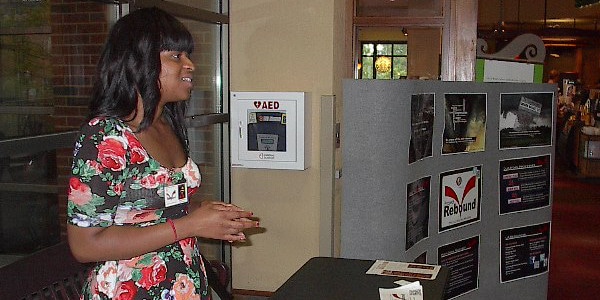A year ago today, deadly tornados plowed through the state of Alabama. The storms tore down buildings and took lives. More than 250 people died statewide. In hard hit Tuscaloosa County, six University of Alabama students were killed. Today’s anniversary conjures up many strong feelings for survivors. And while debris has been cleared and rebuilding continues, the emotional scars linger. But as WBHM’s Andrew Yeager reports, mental health professionals are still working on that part of recovery.
Fat raindrops pound the concrete steps outside the Ferguson Center on the University of Alabama campus. It’s a subtle reminder of the powerful storms that plowed through this community a year ago. Just inside the building, graduate student Arlesia Malone stands by a booth near the entrance to the food court.
“Hello, can I borrow 60 seconds of your time?”
Malone engages a passing student in a quick conversation about the tornado. That student explains she’s just a freshman and wasn’t on campus a year ago. But she does recall being in an evening class this year. As a storm started to roll in, students became anxious. The professor ended up cutting class short because the students were so unsettled. After this story Malone makes her pitch.
“If you know anybody that needs our help, we’re just brief informal counseling. I don’t even have to know a name.”
This is Project Rebound. It’s kind of a mental health, front line of attack. The program involves about 20 graduate students. They hang out in high traffic areas or interact over social media and talk with their peers. In some cases, they meet for basic counseling sessions — for instance, over a cup of coffee. If necessary, they’ll make referrals to professional services. Arlesia Malone says most students seem to be bouncing back, but not everyone.
“I know that I’ve experienced a student on the transit before who says every time it rains she doesn’t leave the house.”
Those stories of unease and anxiety don’t surprise UAB Clinical Psychologist Joshua Klapow. He says the anniversary, thunderstorms and even just the fact we’re in severe weather season can trigger the same emotions and physical reactions victims experienced following last year’s tornado outbreak. And Klapow points out you didn’t have to lose a home to be a victim. Feelings of grief and sadness can resurface in people just witnessed events from afar.
“That’s normal. That’s okay.”
He says the good news is that for most people time does heal wounds. But for one to four percent of victims, the tornado has spawned diagnosable conditions such as post-traumatic stress disorder or clinical depression. Klapow says those symptoms can be brought under control or eliminated.
“But to be honest with you when you come out at a year and you’re that severe, you may continue to have problems at some level for a long time. And when I say some level, this is important. Some level may mean it’s very manageable, but you are scarred in a way that will always affect you.”
Klapow says it’s hard to self-diagnose, but a good question to ask is if my symptoms, such as feelings of anxiety or fear, are keeping me from my regular routines? If so, it’s a good idea to check in with your primary care physician or a trusted clergy member.
The disaster response community continues to reach out too.
“I’m Lisa Turley and I am the state director of Project Rebound, which is a FEMA funded program which is serving the state of Alabama.”
That program at the University of Alabama we noted about a moment ago, it’s a part of this larger statewide effort of the same name. Turley says in the months following the tornados, after the rescue phase ended, volunteers with Project Rebound recanvased affected neighborhoods to connect people with existing mental health resources. They talked with parents and teachers. A hotline remains in operation. The program goes through the end of June, but Turley is thinking beyond that.
“One of our goals is to leave the community, leave individuals stronger. So that when the next storm comes, because sadly we know there’ll be another one, that they’ll have the tools and skills to help themselves and to maybe help neighbors and friends.”
Alabama’s ability to respond to the next disaster though could be hampered. Local mental health facilities depend on funding from the state Department of Mental Health. That agency is already dealing with a $12 million budget cut due to proration. Further cuts are expected next year. Turley says while mental health workers learned a lot from last year’s storm, that experience doesn’t help much if the resources aren’t there to apply it.
“What we need in the long run is we need to have those staff that are already employed, that the money’s available at the mental health center, so we’re not piecemealing a response together, that we have a very systematic response.”
In the meantime, Arlesia Malone at the University of Alabama continues her part to counsel fellow students through the emotional recovery. And her own recovery.
“To hear other people’s stories, kind of helps me cope. So I do admit that while I am a teacher, I am a student as well.”
A student of ongoing lessons, familiar to many this April.

